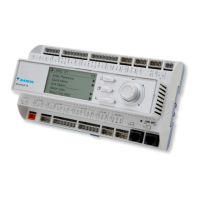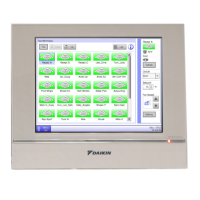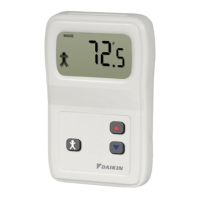Daikin IM 696-4 27
Service Information
4-Compressors/4-Stage or 6-Compressor/6-Stage. In this
configuration there are four compressors and two cooling
circuits. The unit cooling capacity is increased and decreased
by turning on and off compressors. One of the circuits is
designate the “Lead” and the other the “Lag” circuit. For
detailed information regarding circuit lead/lag operation, refer
to the “Compressor Staging” section of the applicable
operation manual (refer to Table 1 on page 1). Disabled
compressors are not turned on.
There are two methods for controll
ing
the two circuits when
both are enabled. These are referred to as Cross Circuit
Loading and Lead Circuit Loading and are described in the
following sections. For detailed information regarding
selecting Cross Circuit Loading versus Lead Circuit Loading,
refer to the “Compressor Staging” section of the applicable
operation manual (refer to Table 1 on page 1).
Cross Circuit Loading. With this method, the two circuits are
alternately loaded and unloaded as evenly as possible.
The normal staging sequence is as follows:
When a capacity increase is required
and the number of
operating compressors in both circuits is the same, the
compressor in the “Lead” circuit with the fewest run hours that
is not operating is turned on. When a capacity increase is
required and the number of compressors in the two circuits is
not the same, the compressor in the “Lag” circuit with the
fewest run hours that is not operating is turned on.
When a capacity decrease is requi
red and
the number of
operating compressors in both circuits is the same, the
operating compressor in the “Lag” circuit with the most run
hours is turned off. When a capacity decrease is required and
the number of operating compressors in the two circuits is not
the same, the operating compressor in the “Lead” circuit with
the most run hours is turned off.
Lead Circuit Loading. With this method, one circuit is loaded
completely before the first compressor in the second circuit is
turned on, and one circuit is unloaded completely before the
other circuit begins to be unloaded.
The normal staging sequence is as follows:
When a capacity increase is required and the number of
operating compressors is 0, the compressor in the “Le
ad”
circuit with the fewest run hours is turned on. When a further
capacity increase is required, the second compressor in the
“Lead” circuit is turned on, fully loading that circuit. When a
further capacity increase is required, the compressor in the
“Lag” circuit with the fewest run hours is turned on. When a
further capacity increase is required, the remaining compressor
on the “Lag” circuit is turned on, fully loading that circuit.
When a capacity decrease is required
, the comp
ressor in the
“Lag” circuit with the most run hours is turned off. When a
further capacity decrease is required, the remaining
compressor in the “Lag” circuit is turned off. When a further
capacity decrease is required, the compressor in the “Lead”
circuit with the most run hours is turned off. When a further
capacity decrease is required, the remaining compressor in the
“Lead” circuit is turned off.
Table 15 on page 28 summarizes the normal binary output
functions and staging sequencing for the CCB1
and CC
B2 for
the 4-compressor/4-stage cooling configuration. Table on
page 28 summarizes the normal binary output functions and
staging sequences for the CCB1 and CCB2 for the
6-com
pressor/ 6-st
age cooling configuration. The Xs in the
table indicate that the output is energized for a particular
cooling capacity.
With either the Cross Circuit Loadin
g or Lead Circuit
Loading
methods, a disabled circuit remains at zero capacity. If the
other circuit is enabled, it acts as the “Lead” and the circuit
capacity is controlled using the Lead Circuit Loading.

